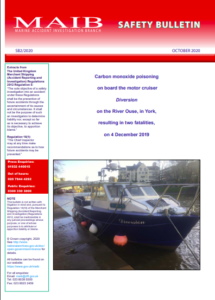UK MAIB issued a safety bulletin highlighting the importance of installing carbon monoxide (CO) alarms on boats with enclosed accommodation spaces. The warning follows a fatal incident involving the motor cruiser Diversion, in December 2019.
The incident
On 4 December 2019, two men returned to 9.18m privately owned motor cruiser Diversion, which was moored on the river Ouse in York.
The diesel fueled heater had been leaking exhaust fumes into the boat’s cabin while they were ashore, and both men were overcome by a high level of carbon monoxide gas and died shortly after they entered the boat’s cabin.
Safety issues
While the investigation is still underway, UK MAIB shared the key safety issues identified:
- no carbon monoxide alarm was fitted
- the cabin heater had been installed by the vessel’s owner, but the installation had not been professionally checked and no servicing had been carried out
This is the fifth fatal marine accident investigated since 2014, where a functioning carbon monoxide alarm could have saved lives, stated Chief Inspector of Marine Accidents.
Carbon monoxide alarms suitable for the marine environment are readily available, inexpensive and simple to fit, and I urge boat owners to invest in one as soon as possible,
…he noted.
Lessons learned
- Diesel-fuelled cabin heaters are frequently installed in boats, trucks, caravans and motor homes. They are readily available to purchase both new and second-hand and may not necessarily be installed by a professional installation engineer. However, it is essential that they are installed in accordance with the manufacturer’s instructions and all components, used in a marine environment, should be approved for marine use. They should also be inspected by a suitably qualifed engineer after installation and be regularly serviced and tested for leaks.
- Carbon monoxide is a by-product of combustion appliances fuelled by oils, solid fuel or gas. It has no smell, no taste, is colourless and is extremely difcult for human senses to detect. Therefore, it is essential that carbon monoxide alarms are ftted in areas where carbon monoxide could accumulate and pose a risk to health (such as the accommodation areas of boats). When selecting a carbon monoxide alarm, preference should be given to those marked as meeting safety standard EN 50291- 2:2010, which are intended for use in a marine environment. It is essential to ft alarms following the manufacturer’s guidance, to test them routinely using the test button and not to ignore them.
- Carbon monoxide is a silent killer. Its symptoms can be similar to colds, fu, hangovers or even Covid-19; headaches, dizziness, nausea, vomiting, tiredness, confusion, stomach pain and shortness of breath. If carbon monoxide poisoning is suspected, stop the source, get to the open air and seek medical attention.
It is commonplace for marine engines, generators, cookers and heaters to produce carbon monoxide during normal operation; amateur installation and un-serviced appliances can introduce the risk of boat users inhaling lethal levels of this toxic gas. The importance of checking the installation and routine servicing of all such devices by a professional cannot be overstated.
Find out more herebelow:

































































